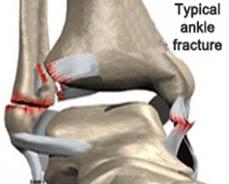Tag Archives: Ankle Cartilage Surgery India Reviews

Low Cost Ankle Cartilage Surgery India

Planning your medical trip to India is a very simple process with Joint Replacement Surgery Hospital India
- You just need to fill in our enquiry form and one of our executives will contact you soon.
- +91-9860432255 Call us at the given contact number for any assistance.
- Complete information regarding surgery is provided on our website.
Ankle fracture (fibula) Introduction-
A fracture is a partial or complete break in a bone. Fractures in the ankle can range from the less serious avulsion injuries (small pieces of bone that have been pulled off) to severe shattering-type breaks of the tibia, fibula, or both.
Ankle fractures are common injuries that are most often caused by the ankle rolling inward or outward. Many people mistake an ankle fracture for an ankle sprain, but they are quite different and therefore require an accurate and early diagnosis. They sometimes occur simultaneously.
The ankle joint is composed of 2 joints: the true ankle joint and the subtalar joint.
The true ankle joint contains the tibia (medial wall), fibula (lateral wall), and talus (the floor upon which the tibia and fibula rest). The true ankle joint allows dorsiflexion and plantar flexion or the “up and down” movement of the ankle. The foot can be made to point toward the floor or toward the ceiling via the true ankle joint.
The subtalar joint consists of the talus and the calcaneus. The subtalar joint allows the foot to be inverted or everted, that is, the sole of the foot can be made to face inward (inverted) or face outward (everted) through the subtalar joint.

During evaluation of ankle fractures, the mechanism of injury (eg, eversion, inversion, dorsiflexion, plantar flexion), associated injuries (eg. vascular, ligamentous, capsular), the need for immobilization (eg, application of a splint), and the need for referral to a specialist for further treatment or evaluation (eg. additional immobilization, surgery, or rehabilitation) are all important components of care.
Causes –
- “Twisting” or rotating your ankle
- “Rolled” your ankle
- Tripping or falling
- Impact during a car accident
Since there is such a wide range of injuries, there is also a wide range of how people heal after their injury.
Check out the Patient Testimonial, where the patient shares about their success stories from treatments through Joint Replacement Surgery Hospital India.
Hello, I am Mr. Edward from the UK. I came to India for my ankle cartilage surgery through Joint Replacement Surgery Hospital India. After an ankle injury, my doctor recommended me to get my ankle cartilage surgery. However, the long waiting patient list at my native place, made me search for the surgery abroad. A friend of mine recommended me about your surgery group in India. He had a wonderful experience with excellent care and quality of service during his medical journey in India. I contacted them with my inquiry and they guided me with the details. I was impressed with their quick response and concern. The surgeon explained me about the surgery over the phone and soon I gave them consent to get my surgery in India. The hospital had a state of the art infrastructure, the surgeon and his staff were true professionals and very caring. My surgery went smoothly. I take this opportunity to thank your surgery group for the amazing job you guys are doing. God Bless!
Symptoms-
An ankle fracture is accompanied by one or all of these symptoms:
- Pain at the site of the fracture, which in some cases can extend from the foot to the knee
- Significant swelling, which may occur along the length of the leg or may be more localized
- Blisters may occur over the fracture site. These should be promptly treated by a foot and ankle surgeon.
- Bruising that develops soon after the injury
- Inability to walk-however, it is possible to walk with less severe breaks, so never rely on walking as a test of whether a bone has been fractured
- Change in the appearance of the ankle – it will look different from the other ankle
- Bone protruding through the skin-a sign that immediate care is needed. Fractures that pierce the skin require immediate attention because they can lead to severe infection and prolonged recovery.
Diagnosis-
Following an ankle injury, it is important to have the ankle evaluated by a foot and ankle surgeon for proper diagnosis and treatment. If you are unable to do so right away, go to the emergency room and then follow up with a foot and ankle surgeon as soon as possible for a more thorough assessment.
Besides a physical exam, X-rays are the most common way to evaluate an injured ankle. X-rays may be taken of the leg, ankle, and foot to make sure nothing else is injured.
Depending on the type of ankle fracture, the doctor may put pressure on the ankle and take a special X-ray, called a “stress test.” This X-ray is done to see if certain ankle fractures require surgery.
Sometimes, a computed tomography (CT, or CAT) scan is done to further evaluate ankle injuries.
For some ankle fractures, magnetic resonance imaging (MRI) may be done to evaluate the ankle ligaments.
Non-surgical treatment-
Treatment of ankle fractures depends upon the type and severity of the injury. At first, the foot and ankle surgeon will want you to follow the R.I.C.E. protocol:
- Rest: Stay off the injured ankle. Walking may cause further injury.
- Ice: Apply an ice pack to the injured area, placing a thin towel between the ice and the skin. Use ice for 20 minutes and then wait at least 40 minutes before icing again.
- Compression: An elastic wrap should be used to control swelling.
- Elevation: The ankle should be raised slightly above the level of your heart to reduce swelling.
Additional treatment options include:
- Immobilization. Certain fractures are treated by protecting and restricting the ankle and foot in a cast or splint. This allows the bone to heal.
- Prescription medications. To help relieve the pain, the surgeon may prescribe pain medications or anti-inflammatory drugs.
Surgical treatment-
- Doctors usually place a splint on the injured ankle for a few days to 2 weeks until the swelling decreases around the joint. The type of fracture and the stability of the fractured joint will determine the type of splint that will be used, or whether surgery is needed.
- If the ankle bones are not aligned properly, the doctor may realign them before placing the splint.
- Surgery will also be needed if any bone has broken through the skin. If the bone breaks through the skin, the fracture is then called a compound fracture. This is more serious than a simple fracture.
- Some minor ankle fractures do not require a splint or cast. In these cases the fracture will be managed as an ankle sprain.
- Because these fractures are very small, they heal well with this management.
- With any injured ankle, however, patients should not bear weight until a cast is placed or until the ankle joint is pain free; check with the orthopedist about when weight bearing should be attempted.
- After the swelling decreases and the patient is reexamined, an orthopedic doctor or a primary care doctor may place a better-fitting cast on the ankle. Depending on the type of fracture, the patient may be placed in a walking cast, which can bear some weight, or the patient may need a non-weight-bearing cast that will require the use of crutches to assist with walking.
- Depending on the degree of pain, the doctor may prescribe pain medication. The patient should use the pain medication only as needed. Do not drive or operate heavy machinery while using these medications.
Follow-up care-
Follow-up care for an ankle fracture depends on the severity of the fracture; consultation with an orthopedist is recommended for most fractures. In some instances, a surgeon may need to be consulted, especially if there is any vascular compromise due to the fracture.
The patient may need emergency surgery, next-day follow-up, or follow-up in 1-2 weeks with an orthopedic doctor.
The patient may require follow-up with a family doctor.
- If the patient’s injured ankle was splinted on the initial visit, he or she will probably need to have a cast placed on the ankle during the follow-up visit.
- Recovery time varies depending upon the type of fracture or need for surgery. The average fracture requires 4-8 weeks for the bone to heal.
- With severe ankle injuries, the doctor may recommend physical therapy for rehabilitation after the acute phase of healing.
Why Choose Joint Replacement Surgery Hospital India for Ankle Cartilage Surgery?
Joint Replacement Surgery Hospital India offers highest quality bone and joint health care with attentiveness, care and compassion to meet the needs of the patients and their loved ones. The medical team includes board-certified orthopedic surgeons who are familiar with all the aspects of the musculoskeletal system. Our hospital uses the most advanced technologies available for the orthopaedic procedures and has a lower complication rate.
If you are really seeking for Ankle Cartilage Surgery, kindly fill up the form for a free consultation with our surgeons. You will be provided with thorough analysis and suggestions regarding the Ankle Cartilage Surgery you are seeking.
Listen to the Voices of Our Happy Patients
FAQ’s
It is a minimally-invasive procedure is performed to stimulate the growth of fibrocartilage in an injured joint. This procedure may be performed with general or regional anesthesia. In preparation for the procedure, the patient is positioned and anesthesia is administered. Fluid is injected to expand the ankle to provide a clear view of the joint. The surgeon makes a series of tiny openings in the ankle to access the joint. The surgeon inserts an arthroscopic camera and instruments into these openings. The surgeon locates and inspects the damaged area with the arthroscope. The surgeon uses arthroscopic instruments to clear away the damaged cartilage. This exposes the surface of the bone beneath the injury. This is followed by stimulating the cartilage growth.
When the procedure is complete, the surgeon removes the arthroscope and instruments and closes the openings in the skin. The patient will be able to return home after a short monitoring period. Following surgery, the ankle may be sore and swollen for four to six weeks. Some patients may wear a walking cast or splint. Others may require crutches for a few weeks. The ankle will heal over a period of months. Physical therapy may be needed.
You can most definitely choose hotels as per your convenience to you and your budget.
You can talk to the doctor and satisfy all your medical queries. You can also send us your queries for answers from the top doctors.
To know about the procedure of getting an Indian Medical Visa, please go to our website where you will find all the details regarding the initial procedure. You can also send us a query regarding the same.
Many hospitals in India have language translators to help you communicate better and effortlessly with the doctors and medical staff.






